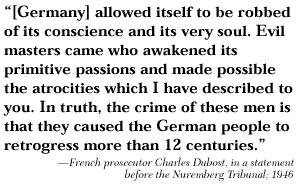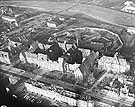
|
|
|

|

|

|

|
|
Click on an image to see a larger, more detailed picture.
|
|
|
|
|
| 1946: The Pursuit of Justice |

|
pg. 651 |

|
|
|
|
| |

|
 The International Military Tribunal at Nuremberg passed judgment on major German war criminals on September 30 and October 1, 1946. Most of the defendants claimed to have been mere subordinates forced to follow orders; only glib armaments minister Albert Speer admitted to wrongdoing. Of the 22 men who were tried at this first and most significant of the war-crimes tribunals (Martin Bormann was tried in absentia), 12 were condemned to death by hanging and seven received prison sentences ranging from ten years to life. (Rudolf Hess, who was sentenced to life, was not in the dock when this photo was taken.)
The International Military Tribunal at Nuremberg passed judgment on major German war criminals on September 30 and October 1, 1946. Most of the defendants claimed to have been mere subordinates forced to follow orders; only glib armaments minister Albert Speer admitted to wrongdoing. Of the 22 men who were tried at this first and most significant of the war-crimes tribunals (Martin Bormann was tried in absentia), 12 were condemned to death by hanging and seven received prison sentences ranging from ten years to life. (Rudolf Hess, who was sentenced to life, was not in the dock when this photo was taken.)
Photo: Archive Photos: id#153. file W287.
|
 Nuremberg was a beautiful medieval city that the Nazis greatly admired for its "Germanness." They even chose it as the location for their annual Party rallies. For these reasons, the Allies selected Nuremberg as the site for the trial of the major war criminals of the Third Reich. This photo shows some of the city's medieval splendor, including the Palace of Justice, where the trials took place. Although the Palace of Justice stood intact, much of Nuremberg did not, for the city had been heavily bombed during the latter part of the war. Many landmarks of which the Nazis were particularly proud--some dating back to 1140--were shattered.
Nuremberg was a beautiful medieval city that the Nazis greatly admired for its "Germanness." They even chose it as the location for their annual Party rallies. For these reasons, the Allies selected Nuremberg as the site for the trial of the major war criminals of the Third Reich. This photo shows some of the city's medieval splendor, including the Palace of Justice, where the trials took place. Although the Palace of Justice stood intact, much of Nuremberg did not, for the city had been heavily bombed during the latter part of the war. Many landmarks of which the Nazis were particularly proud--some dating back to 1140--were shattered.
Photo: AP/Wide World
|
|

|

|

|

|
 October 1, 1946: The verdicts of the first Nuremberg trial are announced. Acquitted: Fritzche; Schacht; Papen. Guilty: Hess, Speer, Raeder, Dönitz, Kaltenbrunner, Streicher, Frank, Funk, Schirach, Ribbentrop, Rosenberg, Göring, Frick, Sauckel, Seyss-Inquart, Jodl, Keitel, Bormann (in absentia).
October 1, 1946: The verdicts of the first Nuremberg trial are announced. Acquitted: Fritzche; Schacht; Papen. Guilty: Hess, Speer, Raeder, Dönitz, Kaltenbrunner, Streicher, Frank, Funk, Schirach, Ribbentrop, Rosenberg, Göring, Frick, Sauckel, Seyss-Inquart, Jodl, Keitel, Bormann (in absentia).
|
 October 11, 1946: Nuremberg defense attorneys are informed by the Tribunal that the appeals of all convicted defendants have been denied.
October 11, 1946: Nuremberg defense attorneys are informed by the Tribunal that the appeals of all convicted defendants have been denied.
|
 October 15, 1946: Hours before his scheduled execution by hanging, Hermann Göring commits suicide in his cell at Nuremberg by biting down on a capsule of cyanide, which may have been secreted inside his pipe.
October 15, 1946: Hours before his scheduled execution by hanging, Hermann Göring commits suicide in his cell at Nuremberg by biting down on a capsule of cyanide, which may have been secreted inside his pipe.
|
 October 16, 1946: Following convictions for war crimes, these men are hanged at Nuremberg Prison: former Nazi Foreign Minister Joachim von Ribbentrop; former Der Stürmer editor Julius Streicher; Nazi jurist Wilhelm Frick; Nazi "philosopher" Alfred Rosenberg; Nazi forced-labor chief Fritz Sauckel; Arthur Seyss-Inquart, former Reich commissioner of Occupied Netherlands; Hans Frank, former governor-general of Poland; Alfred Jodl, former Generaloberst der Wehrmacht and chief of the operations staff of OKW (High Command of the Armed Forces); Ernst Kaltenbrunner, former SS-Obergruppenführer and RSHA chief; and Wilhelm Keitel, former field marshal and chief of OKW. The bodies of the executed, plus Hermann Göring's, are burned in the ovens of the former concentration camp at Dachau, Germany. The ashes are scattered late in the day in the Isar River.
October 16, 1946: Following convictions for war crimes, these men are hanged at Nuremberg Prison: former Nazi Foreign Minister Joachim von Ribbentrop; former Der Stürmer editor Julius Streicher; Nazi jurist Wilhelm Frick; Nazi "philosopher" Alfred Rosenberg; Nazi forced-labor chief Fritz Sauckel; Arthur Seyss-Inquart, former Reich commissioner of Occupied Netherlands; Hans Frank, former governor-general of Poland; Alfred Jodl, former Generaloberst der Wehrmacht and chief of the operations staff of OKW (High Command of the Armed Forces); Ernst Kaltenbrunner, former SS-Obergruppenführer and RSHA chief; and Wilhelm Keitel, former field marshal and chief of OKW. The bodies of the executed, plus Hermann Göring's, are burned in the ovens of the former concentration camp at Dachau, Germany. The ashes are scattered late in the day in the Isar River.
|
|
|
|
|
| 1946: The Pursuit of Justice |

|
pg. 651 |

|
|
The Holocaust Chronicle
© 2009 Publications International, Ltd.
|
|
